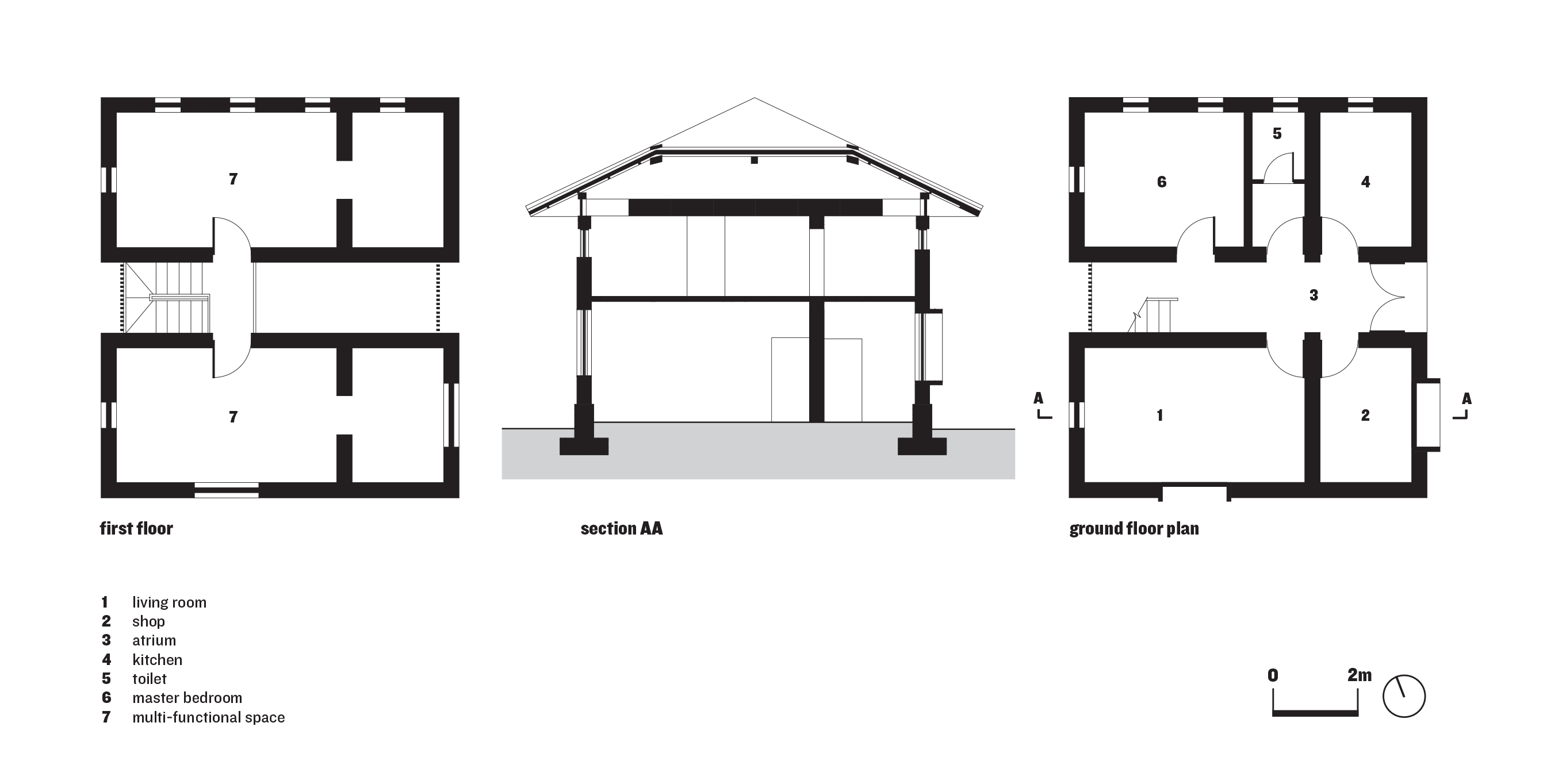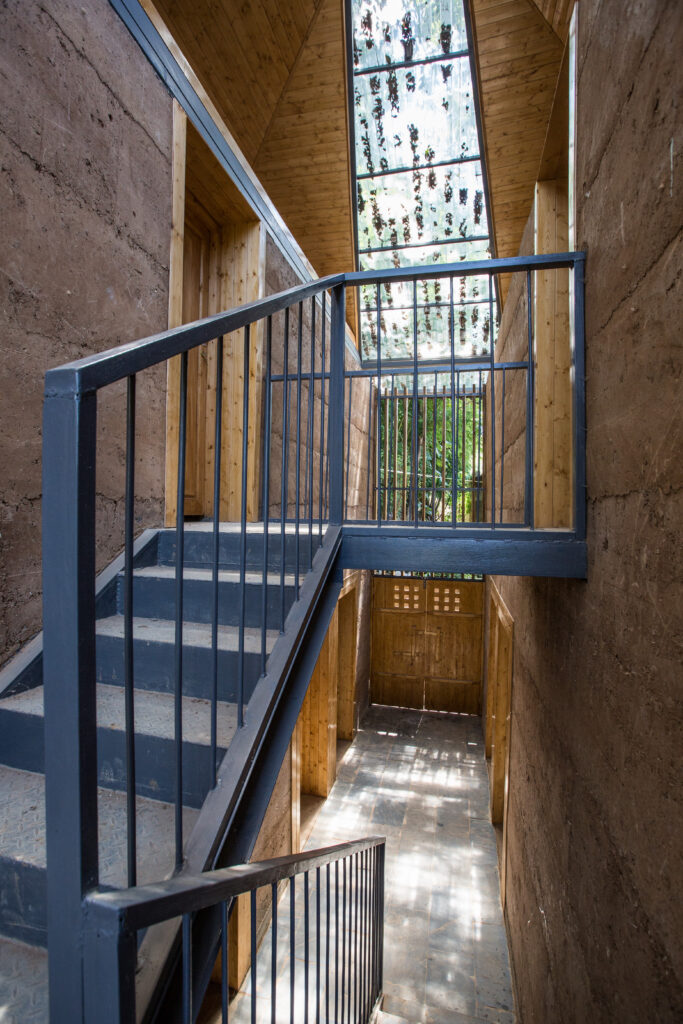AR House Winner: in the wake of a devastating earthquake in Ludian County, China, concrete and brick are sidelined in favour of traditional rammed-earth construction
On 3 August 2014, a magnitude 6.1 earthquake with a depth of 12km hit the mountainous area of Ludian County in Yunnan Province. In total nearly 81,000 homes collapsed, 617 people died and 112 remain unaccounted for. More than 1,800 were injured and 57,000 were relocated, not least because rock falls had dammed the Niulan River threatening villages downstream. It is only because of the low residential density of these rural areas that the death toll wasn’t greater. The relatively busy town of Longtoushanzhen, for example, suffered 80 per cent of the fatalities.
Three years later and two hours’ drive out of Zhaotong City, the vertiginous vegetation along the sheer mountain slopes still reveals geological scars in the bright red earth, dramatic reminders of the landslides in which entire communities were wiped away.
In Guangming Village, with a population of just 61 families, around 10 people died and most of the village’s physical infrastructure was destroyed. At that time, 80 per cent of these old buildings were local rammed-earth constructions, all of which collapsed. The remainder – 10 or so – that had been built in brick and concrete survived relatively unscathed. When President Xi Jinping visited Guangming Village soon after the devastation to inspect the situation, the mud remnants of the old village houses had been dumped over the side of the mountain and many people had quickly rebuilt in brick and concrete to show the speed and effectiveness of the reconstruction programme. The lesson seemed to be that concrete, the ubiquitous symbol of China’s progress, had proved its worth and shown earth construction to be backward and clearly dangerous.

8 award antiseismic house3 site plan
Enter a team of researchers, led by Professor Edward Ng, Dr Wan Li and Xinan Chi of the School of Architecture at the Chinese University of Hong Kong. Together with experts at Kunming University they developed a Rural Sustainable Development Assistance Programme that seeks to help villagers in remote regions to tackle local housing problems as simply and efficiently as possible. With the help of philanthropic funding from a developer in Hong Kong, the team set out to re-engineer the nature of the problem. Instead of promoting the imported benefits of concrete, they set about exploring whether the shortfalls of traditional rammed-earth typology (as well as the fragility of village life) could be addressed in situ. Guangming, for example, has real limitations to reconstruction imposed by poverty, lack of available skills, physical difficulties delivering materials, the cost of transport, wariness of failed construction techniques and the particularities of the climate, as well as an aspiration for bigger, better, more stable modern housing.
One of the obvious solutions to Guangming’s isolation might be to advocate that families leave this remote region and relocate to safer areas with more convenient amenities. But as a response to the government’s countryside regeneration movement, there is now a conscious imperative to reinvigorate local communities such as these – improving their quality of life and work opportunities – to discourage local youth from moving to China’s rapidly expanding neighbouring cities. For as China urbanises, so places like Guangming are rendered devoid of working-age youth: these are the so-called left-behind villages populated by the elderly and their grandchildren.

Mr and mrs yang homeowners
Source: Austin Williams
Mr and Mrs Yang
So on the one hand, employment opportunities are needed. On the other hand, China has been keen to promote local intangible (and tangible) cultural heritage. Writing of rural life, one author recently acknowledged that local village housing doesn’t often fit the common definition of global heritage, but ‘plain dwellings are the foundation of the living circumstances over generations’.
Ludian County’s red clay soil is an archetypal material in its vernacular architectural heritage: it is cheap and plentiful and provides a number of other, less tangible gains that the researchers were keen to exploit. The idea was to reconstruct using local labour and to return some lost rural construction skills. The important starting point was to get the village to accept a non-concrete construction.
The government’s one-off payment of 50,000RMB (around £5,000) for the loss of a family house is significant but not enough for locals to construct a full-sized replacement, especially in expensive concrete frame and brick. Seizing this opportunity to promote low-cost dwellings, the CUHK team has formed a notional aid agency to provide appropriate technological assistance to several inaccessible villages, with strict budget constraints. After that, ‘volunteers’ were found and local labourers recruited.

02 shaking table test
Shaking table test
The original rammed-earth buildings had a high proportion of stone. This may have contributed to their structural collapse so the research team has tested a range of mixes, additives and structural insertions to aid stability. Initial findings showed that the benefits of the new rammed-earth formulation are twofold. First, it is a thermally sensitive material in this particular climate that experiences only minor fluctuations over the year. Here in Yunnan Province, the use of rammed-earth housing creates homes that are warmer than similar concrete buildings in winter and cooler in summer. Second, the first couple of houses used earth that had been salvaged from the earthquake-damaged buildings. The rubble was watered down and reconstituted as a workable material.
This reclaimed earth had to be sieved and soaked for a month before it was of the right consistency and this preparatory work took place while the rubble concrete foundations were being laid. Next, steel shuttering was formed into approximately 1m by 600mm high by 350mm wide blocks and filled with the reclaimed soil mixed with sand, cement, grass and natural fibres (proportions 100, 100, 5, 0.2, 0.2), lightly tamped and allowed to set. The next ‘block’ was laid in the same manner and so on with steel reinforcement bars at vertical intervals. Subsequent shaking table tests reveal that the reinforcing steel adds little stability and now the team is experimenting with horizontal bamboo reinforcement. At the top of the roof is a concrete ring beam.

Local comunity
Source: Austin Williams
Local community
The initial projects have been as much about skilling the labourers as about testing the technology. The main contractor, Yang Qingguang, is the son of the elderly couple who now occupy the house featured in this article. Yang’s own wife was a tragic victim of the earthquake and his parents, aged 79 and 81 years old, had also been living in a tent for 12 months – because of the collapse of their home – before the opportunity arose for a new start.
The house is a simple rectangle on plan and angled to the road, creating a triangular garden where the Yangs have built a small table and chair in ubiquitous concrete and have planted a productive vegetable garden. The house is split in two with a staircase in the middle: a double-height space that is open to the air at both sides and providing a cool shaded area to work and chat. On either side of the corridor are simple square rooms, sparsely furnished in a simple homely fashion. In one corner of the living room, alongside the television and an embroidered Chinese good luck motto, is a photo of Yang’s own father taken in 1900.

8 award antiseismic houseplansnew
There is no heating provided – something that the research team and local builders may address in future projects – but even so, this house exceeds the standard performance of a similar house built in brick and concrete, and regular monitoring of a control building is providing data to prove it. Given that concrete housing is seldom insulated, rammed earth provides excellent thermal performance by comparison (aided and abetted by double glazing in this project) and it also helps regulate humidity, is a low-energy intensive system of building (notwithstanding it is labour intensive), produces little noise or air pollution, and is easy to learn.
Construction of this 72m² two-storey house started in December 2015 and was completed in April the following year. The Yangs are clearly delighted with it and the success of the project has given the locals a sense that, not only might employment opportunities now be made possible in a newly energised local construction industry, but by architect-designing these buildings to include social spaces, passive ventilation, private gardens and an aesthetically pleasing finish, other villagers are now interested in switching back from their concrete and brick houses. As a result, the research team is now working in a few other villages, importing the initial labourers as site foremen to oversee the next generation of trainees. It is also building a rammed-earth training centre at Kunming University for academic and practical research.
But the research team has been eager to point out that this is not some alternative technology miracle solution to the world’s problems. ‘It isn’t even appropriate for most of China’, says Dr Li Wan. It is a geologically and climate-defined solution for this particular area. More importantly, it is a simple stepping stone to put real people’s lives back together.
Project data
Architects Edward Ng, Li Wan, Xinan Chi of the School of Architecture at the Chinese University of Hong Kong; Kunming University
Engineer Wenfeng Bai
This piece is featured in the AR’s July/August 2017 issue on houses – click here to purchase a copy
 The Architectural Review An online and print magazine about international design. Since 1896.
The Architectural Review An online and print magazine about international design. Since 1896.












